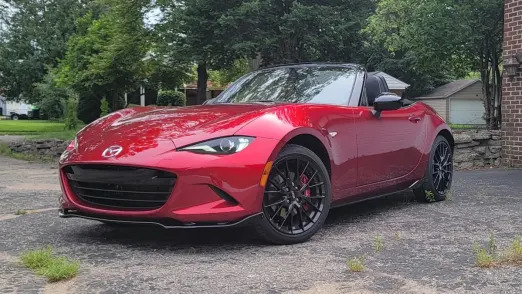Make time for a Miata

The single most wonderful perk of this job is the cars. Some are exciting; others are more mundane. Sometimes, a loaner car may sit for five of the seven days I have it in my driveway, a casualty of a busy life and a vocation that has me on the road nearly as often as not. But whenever I have the opportunity to drive a Miata — like the 2024 Club model pictured above — I make time.
Some cars are the main event; others are simply accessories. A third category entirely comprises just those rare machines that will eagerly retreat into the margins in the quest to provide a better driving experience. That’s the Miata: always ready, ceaselessly deferential. And for most normal people, utterly useless.
There was a time when I had no interest in owning one — zero, zip. not even an iota. In fact, when I first decided to dabble in amateur motorsports, I went out of my way to look at just about anything else to campaign. I wasn’t even so much opposed to the Miata itself as I was to its general popularity. Call it the rebelliousness of youth; I was dead set against it. And then, as tends to happen, one practically fell into my lap.
I bought my NA in 2008, just as the final wave of the $1,500 Miata phenomenon was receding (I paid $1,350). I’ve never owned another car as long as I’ve owned that Miata, nor do I expect I ever will. I certainly have no desire to sell it. It costs me nothing to own, and despite not having to rely on it (I have two other cars plus whatever Autoblog decides to send my way), it fires right up on command, asking only the attention of a modestly priced battery maintainer.

The shifter, sway bar and suspension bushings were all hanging on by desiccated threads. The shocks were original. The odometer read 210,000 miles. Not a single body panel was untouched by time, careless parkers or both. The “tombstone” piece of trim covering the center stack was missing entirely. There was a curious whine at steady speeds. A dying rear end? A failing wheel bearing? Crappy, unevenly worn tires?
I didn’t care. I knew the instant I turned the key that I was going to buy it.
An inspection revealed myriad small issues but no large ones. A suspension refresh and new tires cured the biggest ailments; the cosmetic bits were relegated to a short list that has only grown since — much like the then-nascent rust perforations in the Miata’s rocker panels.
I have that little Miata to thank for saving me a bundle of money. If it weren’t for my 200,000-mile clunker, I’d have certainly spent far more on a newer version of it by now. It’s like a vaccine for my finances; a few hundred spent maintaining that ratty little rust bucket inoculates me against spending thousands (or tens of thousands) on a newer, shinier example.
Because while they may indeed be shinier, new Miatas don’t really do much more than older Miatas — a fact of which I’m reminded every time one shows up in my driveway. Driving the latest doesn’t make me want to run out and buy a new one; it makes me want to invest more into making my now-34-year-old example roadworthy again. Mazda’s engineers have remained steadfastly dedicated to the roadster’s formula for the entirety of those three-plus decades. People often like to debate the merits of each generation, but at the end of the day it’s quite simple: The best Miata is the one you already own.

Despite its widespread adoration, there’s plenty the Miata is objectively bad at, and pretty much all of it stems from its size. It’s hard to describe to the uninitiated just how small a Miata is. Its cabin is cramped and utterly devoid of anything but the most fundamental of creature comforts. Back when Mazda’s little roadster was new, you could buy economy cars specced this way. Today, even the cheapest micro-CUVs feel palatially appointed compared to the ND roadster. And there’s no room to make your own space, either. In fact, if you plan to bring along both a beverage and a passenger, one of them is going to have a bad time.
This dearth of functionality is unheard of even in most of today’s sporty cars. The Toyota GR86 and Subaru BRZ may compete with the Miata in spirit, but they’re full-blown family haulers by comparison. Permanent cup holders? Functional storage cubbies? Back seats? Roofs? Might as well be minivans. Even the Corvette’s cabin feels indulgent after a stint in the Miata — and believe me, I’ve done my share.
Why was I so resistant for so long? Simple: I was a child of the magazine era, and the things that make the Miata great don’t translate all that well to print. The performance figures certainly aren’t staggering, and while the little roadster has always been able to count its looks among its positive attributes, it certainly doesn’t sell itself on sex appeal. The first-gen Miata didn’t look any more beastly next to a C4 Corvette or 964 than the current car does next to a C8 or 992.
But every time I fire up a Miata, new or old, I feel that same jolt. That same sense that this machine was built just for people like me. I love my CT4 Blackwing because it can do everything; I love my Miata because it can’t.
Drive one. You’ll see.



